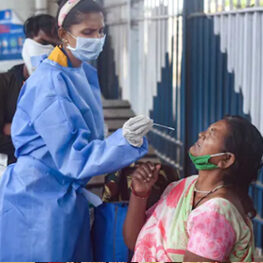India is conducting 18-20 lakh tests for detection of COVID-19 per day, the Indian Council of Medical Research (ICMR) said on Tuesday underlining that despite infection among laboratory staff, the test performance is still being maintained. Addressing a press conference, ICMR director general Dr Balram Bhargava said in the second wave, three initiatives were taken — rationalising RT-PCR tests, increasing RAT testing for early detection, isolation and home care and third COVID-19 tests approved by reputed global agencies have been accorded marketing permission by DCGI.
RATIONALISING TESTS
In terms of rationalisation of RT-PCR tests, he said RT-PCR must not be repeated in individuals tested positive once either by RAT or RT-PCR. No testing is required for recovered individuals at the time of hospital discharge and there is no need for RT-PCR tests in healthy individuals undertaking inter-state domestic travel.
Non-essential travel and interstate travel of symptomatic individuals should be essentially avoided. All asymptomatic individuals undertaking essential travel must follow COVID appropriate behaviour, he said, adding that mobile testing laboratories are also being deployed.
Dr Bhargava said the national COVID-19 positivity rate is around 21 per cent and about 42 per cent (310/734) of the districts are reporting a positivity rate more than the national average.
TESTING STRATEGY
Stressing that early testing, isolation and home-based care is the key to control transmission, Bhargava said, “The RT-PCR testing capacity is about 16 lakh per day in our laboratories and RAT capacity is also around 17 lakh per day.” “Laboratories are working 24X7 to meet the increased testing demand. Despite infection among laboratory staff, test performance is still being maintained,” he said. Giving an example, Bhargava said that in the month of April and May, they were doing, on an average, 16-20 lakh RTPCR and RAT tests combined per day.
At present, there are 2,520 COVID-19 government and private molecular testing labs, over 7,000 RT-PCR machines and over 3,800 TrueNat and CBNAAT machines. A total 30,04,10,043 samples have been tested up to May 7 in India.
“COVID-19 tests approved by reputed global agencies have been accorded marketing permission by the DCGI and home-based testing solutions are also being explored,” he added.
COVID AMONG KIDS
In response to a question on whether children are getting more affected, Bhargava said the comparison of data during the first and second wave of COVID has shown that there is not much age difference and people above age of 40 are more vulnerable for adverse outcomes.
“We have found that younger people are getting slightly more involved because suddenly they have gone out and there are variants also prevalent in the nation which may be affecting them as well,” he said. Bhargava further said that if one has fever with or without cough, headache, sore throat, breathlessness, body ache, recent loss of taste or smell, fatigue, diarrhea, then they should be tested immediately, and while awaiting test results, they should be isolated. Some people make the mistake of monitoring pulse rate, he said, adding that those in home isolation should not confuse pulse rate as oxygen saturation.
“COVID-19 tests approved by reputed global agencies have been accorded marketing permission by the DCGI and home-based testing solutions are also being explored,” he added.
COVID AMONG KIDS
In response to a question on whether children are getting more affected, Bhargava said the comparison of data during the first and second wave of COVID has shown that there is not much age difference and people above age of 40 are more vulnerable for adverse outcomes.
“We have found that younger people are getting slightly more involved because suddenly they have gone out and there are variants also prevalent in the nation which may be affecting them as well,” he said. Bhargava further said that if one has fever with or without cough, headache, sore throat, breathlessness, body ache, recent loss of taste or smell, fatigue, diarrhea, then they should be tested immediately, and while awaiting test results, they should be isolated. Some people make the mistake of monitoring pulse rate, he said, adding that those in home isolation should not confuse pulse rate as oxygen saturation.
